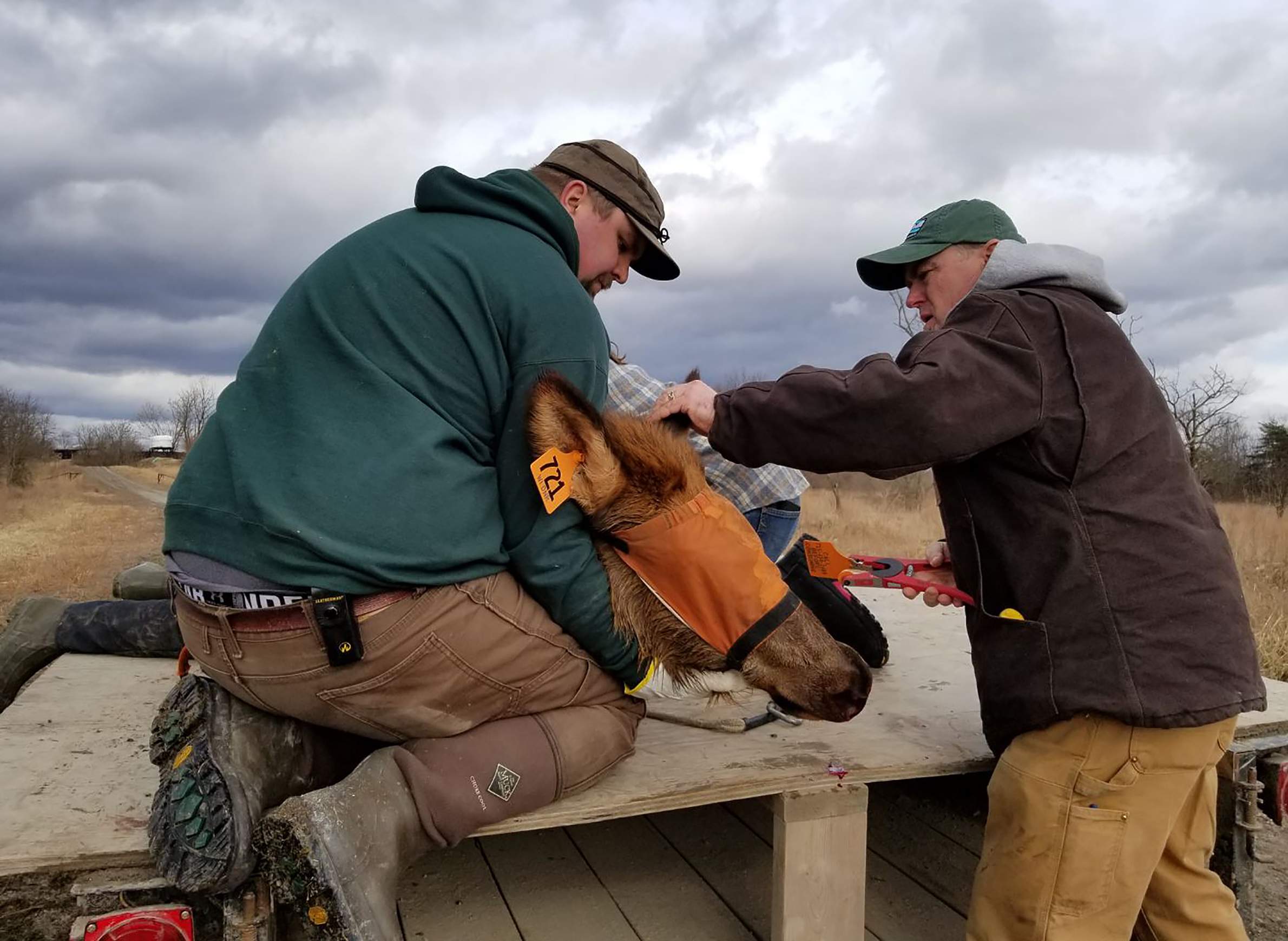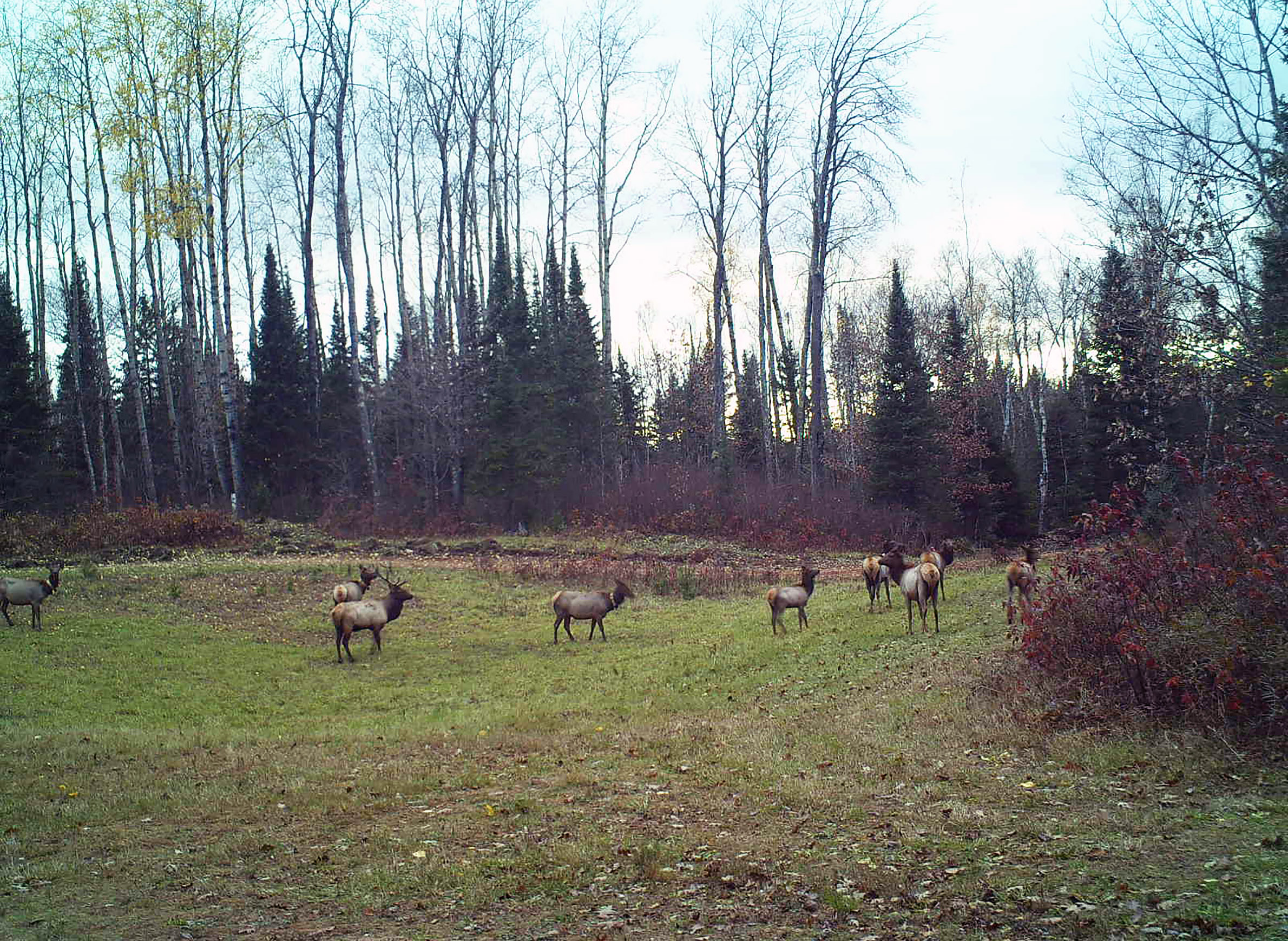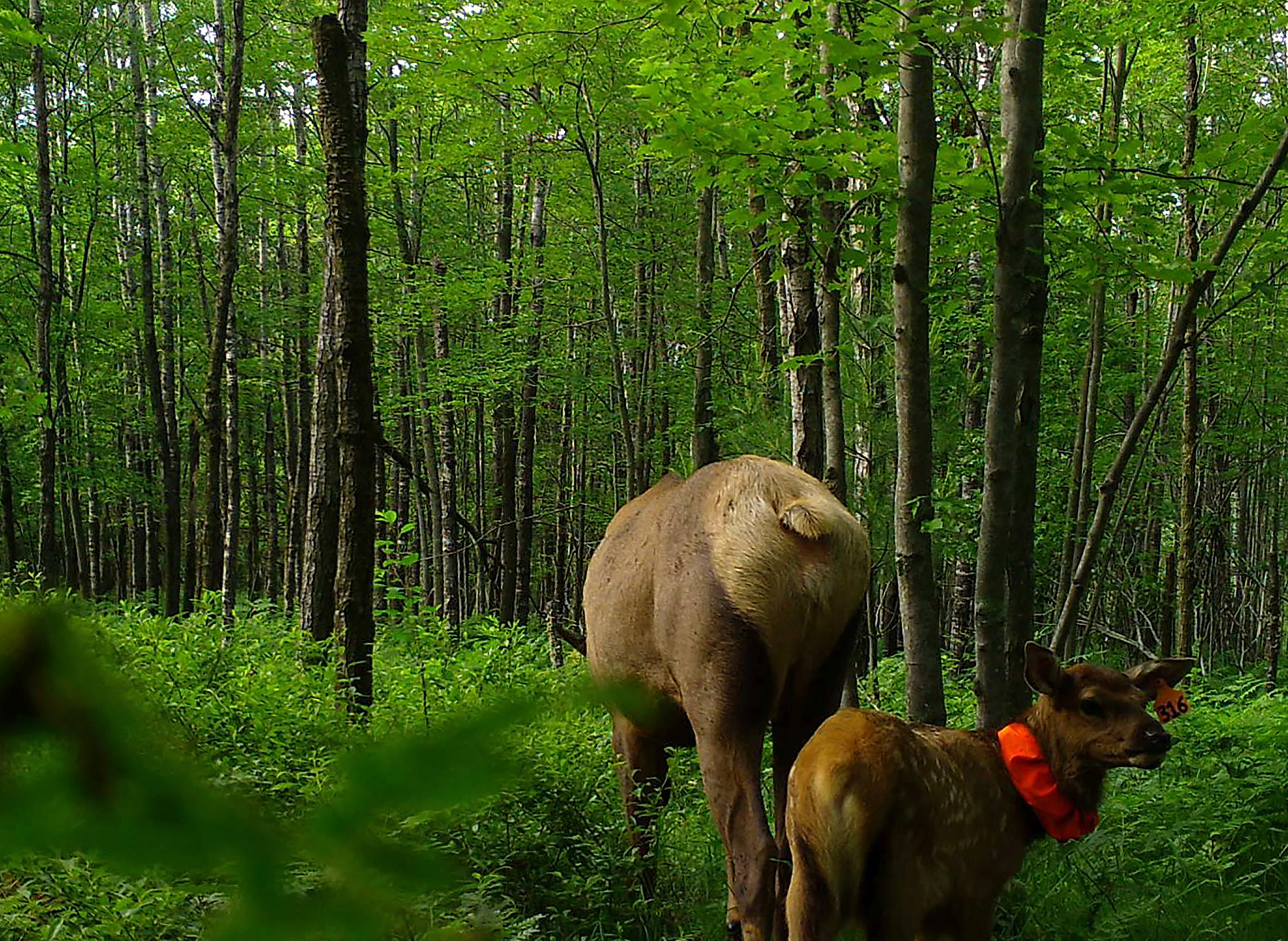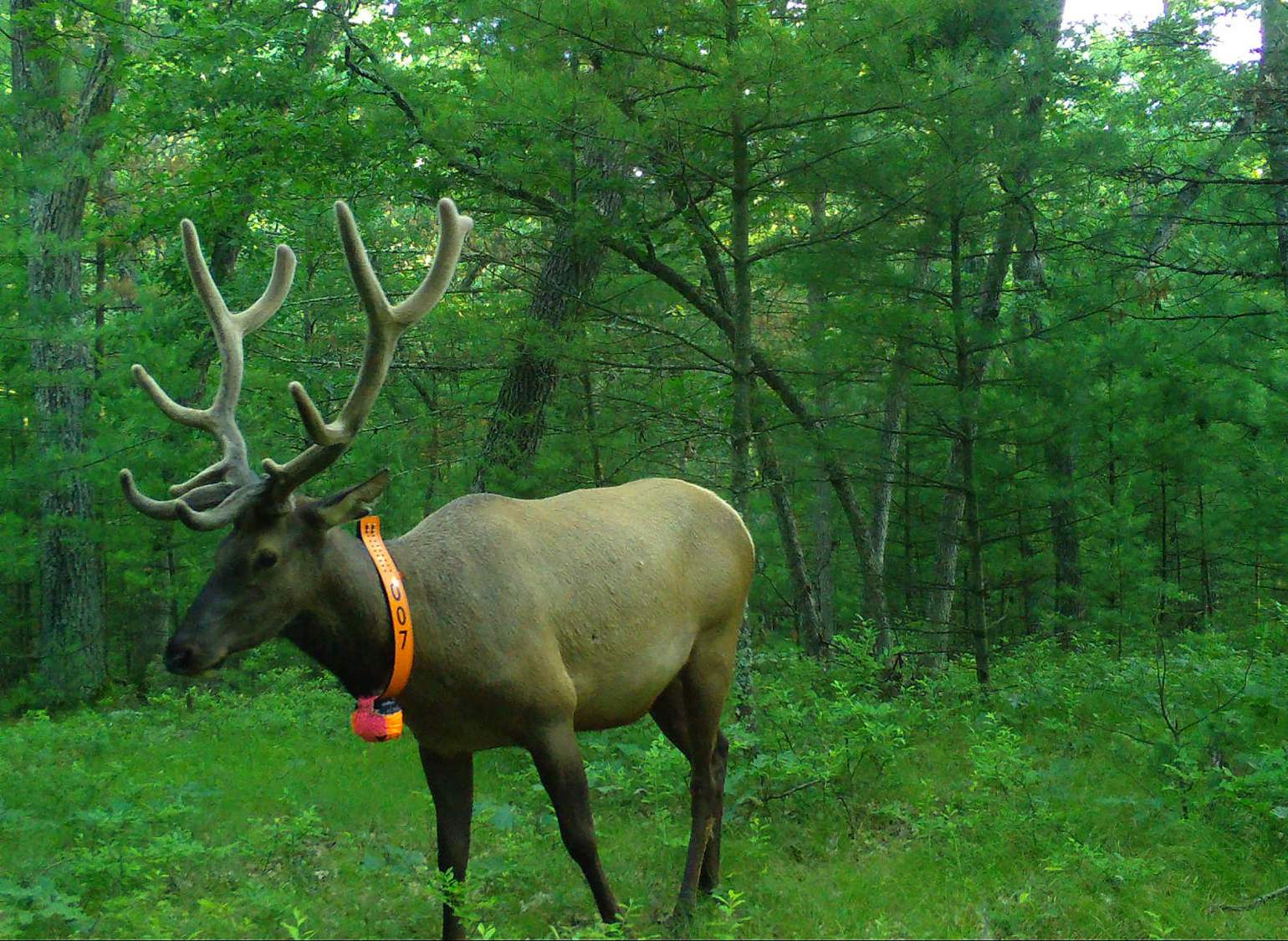The threat of chronic wasting disease to Wisconsin's booming whitetail deer herd is motivating efforts to track and research its spread, but this deadly ailment also imperils efforts to reintroduce wild elk to the state.
Unlike Wisconsin's deer population, which was estimated to be around 1.5 million in late 2018, its two elk herds are miniscule: One numbers in the low hundreds, while the other barely tops 70 animals.
So far, no wild elk in Wisconsin have tested positive for this fatal neurodegenerative disease that affects cervids, a group of hooved mammals including deer, elk, moose, caribou and reindeer. Meanwhile, CWD infections among wild deer have not been documented in the home ranges of the state's elk herds, which are located in two small pockets of northern and west-central Wisconsin.
But CWD continues to spread within Wisconsin's whitetail deer herd, emanating from an area near the border of Dane and Iowa counties where it was first identified. At the same time, the disease has cropped up on deer and elk farms around the state.
The spread of CWD is raising concerns that it could soon be found in wild elk territory. While this prospect threatens the health of Wisconsin elk, also hanging in the balance are a decades-long effort and millions of dollars spent to build these herds from nothing and create a new hunting tradition in the state.
The return of elk to Wisconsin
In 2018, around 38,000 Wisconsin residents paid $10 a piece for a chance to harvest a wild bull elk in the state's first-ever managed elk-hunting season. The Wisconsin Department of Natural Resources distributed 10 elk tags, five to Wisconsin tribal members and five to non-tribal residents, and nine bulls were harvested.
In 2019, more than 23,000 would-be elk hunters in the state put their names in a lottery for licenses. In addition to Ojibwe tribal members who harvested five elk, the DNR again awarded elk tags to a mere five lucky individuals. The small number of tags in each year reflects the state's relatively tiny herds.
The larger and older of the state's two elk herds is centered near Clam Lake in southwestern Ashland County, in the midst of the Chequamegon-Nicolet National Forest. The Clam Lake herd numbers about 250 animals — considerably more than the state's other herd of around 75 elk living within the Black River State Forest in Jackson County.
These 300-odd wild elk presently roaming Wisconsin forests are among the first to do so in more than a century. Like many wildlife species, elk fell victim to expanding European settlement across eastern North America in the 19th century. Unregulated hunting and loss of habitat spelled the end of wild elk in Wisconsin between the 1860s and 1880s.
But the creatures persisted in western North America. Their majestic antlers and imposing bodies also lived on within the imaginations of generations of conservationists and hunters in Wisconsin. After a failed attempt to reintroduce elk to the state in the early 20th century, interest began growing again in the 1980s.
In 1989, the Wisconsin Legislature directed the DNR to conduct a feasibility study to gauge the viability of reintroducing elk, moose and caribou to the state. At the time, the DNR determined there were too many potential threats and not enough public support to justify reintroduction attempts for any of the three species.
However, the study helped kick off a grassroots effort to reintroduce elk in Wisconsin. Finally, in 1995, researchers at the University of Wisconsin-Stevens Point, in concert with the conservation nonprofit Rocky Mountain Elk Foundation, moved a small number of elk from Michigan to the Clam Lake area to study whether the animals could survive and build a herd in Wisconsin.
After a few years of modest population growth, the UW-Stevens Point study ended, and the DNR took over management of the Clam Lake herd. Throughout the 2000s, interest in the small Wisconsin elk herd grew, as did enthusiasm for reintroducing the animals elsewhere in the state. By 2011, the DNR began working with the same nonprofit and the state of Kentucky to bring more elk to the state.
In 2015 and 2016, 73 Kentucky elk were successfully released in Jackson County, explained Kevin Wallenfang, a deer and elk ecologist for the DNR's Bureau of Wildlife Management who leads the state's elk management program. By spring 2019, 83 more elk from Kentucky were released near the Clam Lake herd to bolster its population and introduce more genetic diversity.
Both elk herds are successfully reproducing, Wallenfang said, but they remain small. That's part of the reason why the DNR is remaining extremely vigilant as CWD spreads in Wisconsin.
Wallenfang pointed to the 2018 and 2019 elk hunting seasons as an indication that the decades-long effort had reached a milestone in the herds' long-term viability.
"It's a measure of success if you can grow that population to the point where you can allow recreational hunting," Wallenfang said. "But that's not the reason we're doing this. If you talk to the original people that wanted to bring elk into the state from the grassroots level … they wanted to bring a native species — this big, beautiful critter — back to the state."
At the same time, growth of the two herds could allow for more elk tags to be distributed in the annual hunt, and would likely bolster local tourism, Wallenfang said. He noted that communities near each herd are already seeing an uptick in visitors hoping to view a wild Wisconsin elk.
It's not only the future viability of the elk herds and the economic and ecological benefits they produce that the DNR is trying to protect, but the massive investment of time and money that has already gone into the effort.
Much of the project's funding has come from the Rocky Mountain Elk Foundation, which primarily raises money through donations, but the Ho-Chunk Nation, several Ojibwe bands and a number of counties, businesses and individuals have also contributed to the most recent reintroduction efforts. Wallenfang said logistics related to that cost more than $600,000. The annual elk hunt is a revenue generator for ongoing management now that relocation efforts have ended, with $7 of each $10 tag application fee going toward the DNR's elk program.
Altogether, up to 30 DNR staff members have worked on the project in some capacity, Wallenfang estimated.
"We have a huge investment in this," he said. "So we're going to do everything we can to try to prevent the disease from getting to elk."
How CWD could affect Wisconsin elk
CWD is a degenerative disease affecting the nervous system of infected cervids. The disease is caused by abnormal proteins, called prions, that multiply and replace healthy brain proteins in infected cervids. (It has not been found to infect humans.) The brains of deer, elk and other animals with the disease progressively deteriorate as the malfunctioning proteins multiply, eventually leading to weight loss, muscle weakness and death.
The disease was first identified in 1967 in herds of mule deer in Colorado. Since then, CWD is known to have spread to dozens of states, Canada, Europe and South Korea, infecting both wild and captive cervids. It spreads via the prions themselves, which infected animals excrete into the environment along with their saliva, urine and other bodily fluids.
Historically, CWD has hit deer species harder than elk. As many as half the deer in infected regions have tested positive for the disease, while the rate among infected elk herds has topped out around one in ten. Still, prevalence rates vary widely within species by region and habitat, and estimating them is difficult because there is no test for live animals.
Kevin Wallenfang, the DNR elk ecologist, and Tom Toman, a longtime staff biologist at the Rocky Mountain Elk Foundation, both pointed to the lower CWD prevalence rate among elk as one reason to hope the Wisconsin herds would remain healthy. Both acknowledged, however, that it remains unclear why prevalence rates tend to be lower in elk than deer.
"Are elk less vulnerable, or are their characteristics and behavior different enough that they just don't contact CWD as much?" Toman said.
One idea is that elk's grazing and social habits could make the creatures less likely than deer to encounter infectious prions in the environment. On the other hand, most prevalence estimates have been made for Western elk herds, which have significantly different behaviors than their counterparts in the eastern half of the United States due to differing habitats.
Even if elk are less susceptible to CWD than deer, the disease is still fatal in infected animals.
Nohra Mateus-Pinilla is the director of the Wildlife Veterinary Epidemiology Laboratory in the Illinois Natural History Survey at the University of Illinois. She helps lead the state's efforts to document and slow the spread of CWD within the Illinois whitetail deer herd.
While her work does not directly focus on CWD in elk, Mateus-Pinilla has researched the disease's transmission, prevalence and management strategies across species. She pointed to 2018 findings of Colorado Parks and Wildlife that show CWD affecting about one-third of the state's elk herds, with increasingly serious potential consequences for their long-term health and viability.
"In some of those populations of elk that have been infected with CWD, there is a decrease in the growth of the herd, and certainly there is a mortality associated with chronic wasting disease that ultimately will impact the herd," said Mateus-Pinilla.
Though the Wisconsin elk herds are reproducing, one way they could be susceptible to CWD over the long term is a function of basic elk biology: Cows give birth to just one calf at a time. This birth rate sets a relatively low ceiling on a herd's potential population growth. Deer, meanwhile, often give birth to two or sometimes even three fawns each spring.
However, elk calves tend to have better survival rates than deer. That's so far been the case in Wisconsin, according to Wallenfang. He noted that all 30 calves born in the Jackson County herd in 2018 and 2019 have survived so far, adding to his optimism that the herds can weather CWD.
Reducing the risk of CWD to elk
There is one aspect of elk behavior that may increase the risk of CWD to the Wisconsin herds: Bull elk in particular often range over much larger areas than deer. This difference can place Wisconsin elk at risk even if CWD hasn't spread to their home ranges. If an elk strays into an area with CWD, it could potentially become infected and carry the infectious prions back to its herd.
The risk of transmission within a herd would grow substantially if an infected elk were to return and live among the herd during the course of the disease, according to Nohra Mateus-Pinilla, the Illinois-based wildlife epidemiologist.
"What is problematic with chronic wasting disease is really the length of time that these animals are infected and that slow death process," Mateus-Pinilla said. "The longer an animal is infected, the more of that infectious protein is being created in the individual animal. This means the infected animal has a greater opportunity to release infectious proteins in their fluids."
That risk is part of the reason why the DNR is taking no chances when an elk strays from its herd into an area where it could conceivably be infected with CWD. Because many of the elk wear radio collars, the DNR is able to track their movements into potentially contaminated areas.
"We've had a couple of situations where we've had an elk, for whatever reason, go on a walkabout and end up in areas with CWD," Wallenfang said. "The likelihood that an elk would walk through a township that has CWD and actually get CWD is extremely miniscule, but to be on the safe side, we've euthanized those elk."
Mateus-Pinilla, who is not involved in Wisconsin's elk or deer herd management, endorsed the measure.
"I would have done exactly the same thing," she said. "When you realize that your only opportunity here is to keep the prions away from the elk populations, it seems to me that that is a very reasonable approach."
Tom Toman, the biologist from Rocky Mountain Elk Foundation who helped manage the reintroduction of elk from Kentucky to Wisconsin, agreed.
"That's good disease management and elk management," Toman said. He noted that Kentucky elk were chosen to build Wisconsin's herds because that state has no recorded incidence of CWD in any deer or other cervids.
Looking toward future growth
Overall, DNR ecologist Kevin Wallenfang is bullish on the future of Wisconsin's elk, though he acknowledged that their fate will depend in part on controlling the spread of CWD among Wisconsin's wild deer — a goal the state has struggled with over the years.
Still, at present Wallenfang considers vehicles and wolf predation to be greater threats to the state's elk than CWD.
"Vehicle accidents in the Jackson County herd are the number one killer of elk," he said.
Those collisions have contributed to slow growth in the Jackson County herd, whose population has so far remained relatively stagnant even with 100% calf survival. On the other hand, after years of slow growth, Wallenfang predicted the Clam Lake herd is finally on the cusp of a population boom.
"We are going to be over 100 breeding-age cows next year [in Clam Lake]," he said. "We anticipate that we're finally on the brink of that growth."
What The Advance Of CWD Means For Wisconsin's Elk was originally published on WisContext which produced the article in a partnership between Wisconsin Public Radio and PBS Wisconsin.
Memberships
Steve is a member of LION Publishers , the Wisconsin Newspaper Association, the Menomonie Area Chamber of Commerce, the Online News Association, and the Local Media Consortium, and is active in Health Dunn Right.
He has been a computer guy most of his life but has published a political blog, a discussion website, and now Eye On Dunn County.









Add new comment